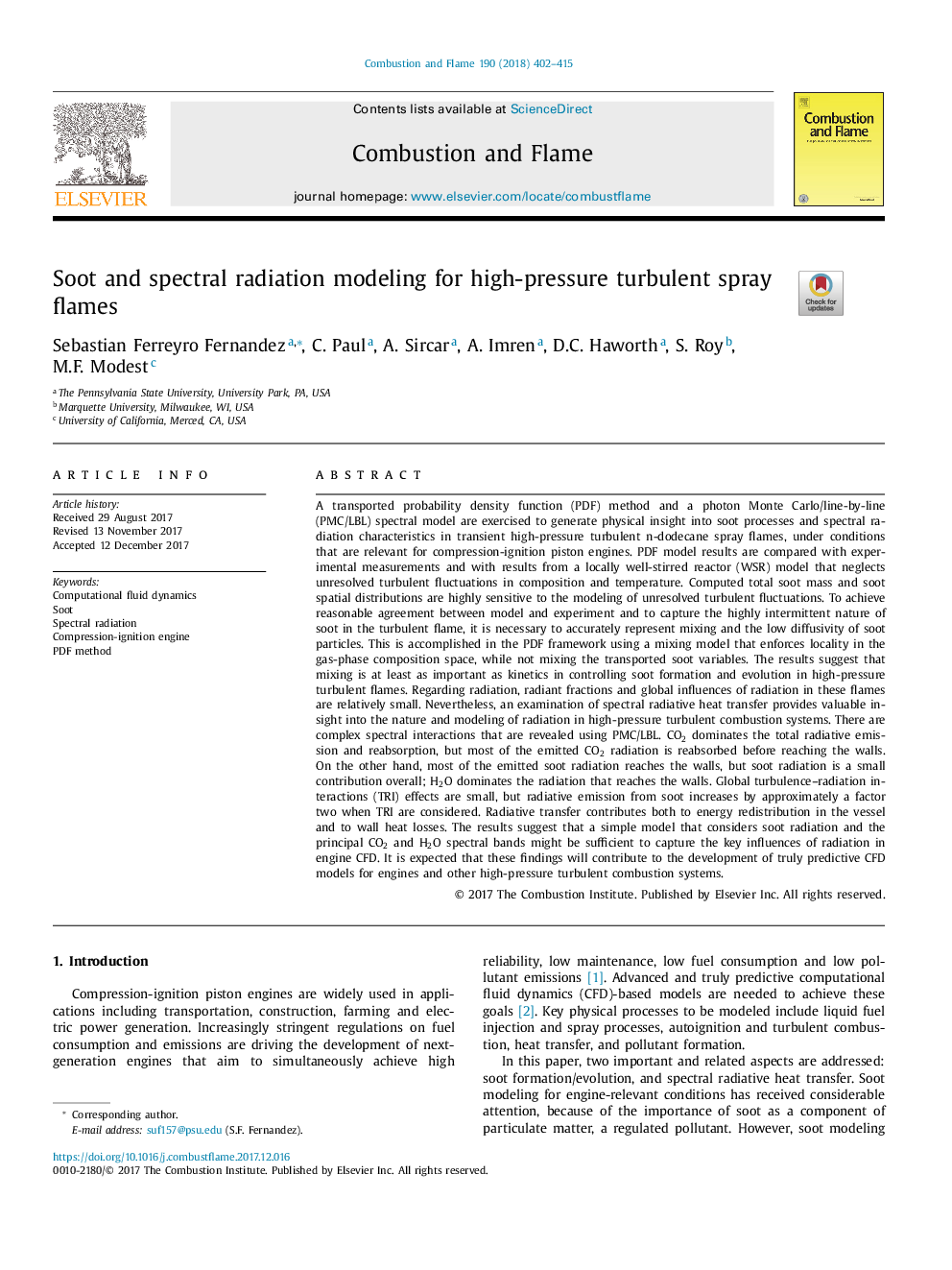| کد مقاله | کد نشریه | سال انتشار | مقاله انگلیسی | نسخه تمام متن |
|---|---|---|---|---|
| 6593868 | 1423547 | 2018 | 14 صفحه PDF | دانلود رایگان |
عنوان انگلیسی مقاله ISI
Soot and spectral radiation modeling for high-pressure turbulent spray flames
ترجمه فارسی عنوان
مدلسازی تابش طیفی و طیفی برای شعله های آتش فشرده با فشار بالا
دانلود مقاله + سفارش ترجمه
دانلود مقاله ISI انگلیسی
رایگان برای ایرانیان
کلمات کلیدی
موضوعات مرتبط
مهندسی و علوم پایه
مهندسی شیمی
مهندسی شیمی (عمومی)
چکیده انگلیسی
A transported probability density function (PDF) method and a photon Monte Carlo/line-by-line (PMC/LBL) spectral model are exercised to generate physical insight into soot processes and spectral radiation characteristics in transient high-pressure turbulent n-dodecane spray flames, under conditions that are relevant for compression-ignition piston engines. PDF model results are compared with experimental measurements and with results from a locally well-stirred reactor (WSR) model that neglects unresolved turbulent fluctuations in composition and temperature. Computed total soot mass and soot spatial distributions are highly sensitive to the modeling of unresolved turbulent fluctuations. To achieve reasonable agreement between model and experiment and to capture the highly intermittent nature of soot in the turbulent flame, it is necessary to accurately represent mixing and the low diffusivity of soot particles. This is accomplished in the PDF framework using a mixing model that enforces locality in the gas-phase composition space, while not mixing the transported soot variables. The results suggest that mixing is at least as important as kinetics in controlling soot formation and evolution in high-pressure turbulent flames. Regarding radiation, radiant fractions and global influences of radiation in these flames are relatively small. Nevertheless, an examination of spectral radiative heat transfer provides valuable insight into the nature and modeling of radiation in high-pressure turbulent combustion systems. There are complex spectral interactions that are revealed using PMC/LBL. CO2 dominates the total radiative emission and reabsorption, but most of the emitted CO2 radiation is reabsorbed before reaching the walls. On the other hand, most of the emitted soot radiation reaches the walls, but soot radiation is a small contribution overall; H2O dominates the radiation that reaches the walls. Global turbulence-radiation interactions (TRI) effects are small, but radiative emission from soot increases by approximately a factor two when TRI are considered. Radiative transfer contributes both to energy redistribution in the vessel and to wall heat losses. The results suggest that a simple model that considers soot radiation and the principal CO2 and H2O spectral bands might be sufficient to capture the key influences of radiation in engine CFD. It is expected that these findings will contribute to the development of truly predictive CFD models for engines and other high-pressure turbulent combustion systems.
ناشر
Database: Elsevier - ScienceDirect (ساینس دایرکت)
Journal: Combustion and Flame - Volume 190, April 2018, Pages 402-415
Journal: Combustion and Flame - Volume 190, April 2018, Pages 402-415
نویسندگان
Sebastian Ferreyro Fernandez, C. Paul, A. Sircar, A. Imren, D.C. Haworth, S. Roy, M.F. Modest,
